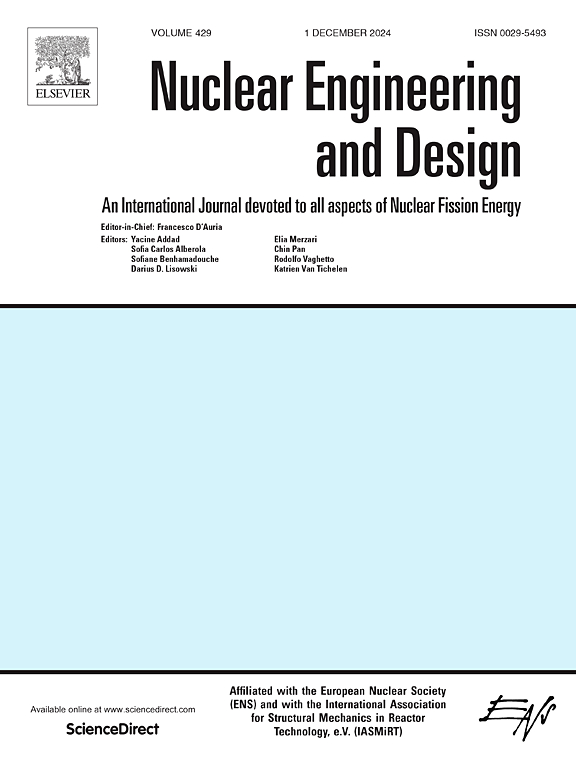在Python环境/架构中使用MELCOR和DAKOTA耦合的Phebus FPT1的不确定性量化应用
IF 2.1
3区 工程技术
Q1 NUCLEAR SCIENCE & TECHNOLOGY
引用次数: 0
摘要
在过去的几年中,国际核科学界参与了严重事故(SA)领域确定性安全分析的发展,并将其兴趣集中在使用最先进的整体SA代码(例如ASTEC, MAAP, MELCOR等)进行不确定性量化的方法分析上。在此框架下,由CIEMAT(西班牙)协调的H2020“严重事故的管理和不确定性”(MUSA)项目旨在建立一种将不确定性量化方法应用于安全事故的统一方法。与由意大利ENEA协调的MUSA工作包“UQ方法在积分实验中的应用”一起,不确定性分析方法已应用于Phebus FPT1实验。为了开发参考基准案例,选择了积分代码MELCOR 2.2,并将其与不确定性工具DAKOTA相结合进行不确定性分析。将MELCOR气溶胶杂项常数作为不确定输入参数,将悬浮在容器大气中的气溶胶总质量的最大值作为优值(FOM),研究重点放在测试的降解和气溶胶阶段的开始上。不确定性分析允许对FOM的不确定性带宽进行首次估计,并将其与实验值和参考案例值进行比较。在不确定输入参数中,动态形状因子和集聚形状因子分别与FOM存在中等和显著的统计相关性。本文章由计算机程序翻译,如有差异,请以英文原文为准。
Uncertainty quantification application on the Phebus FPT1 using the coupling of MELCOR and DAKOTA in a Python environment/architecture
During the last few years, the international nuclear scientific community involved in the development of deterministic safety analyses in the Severe Accident (SA) domain has focused its interest on the analysis of methodologies for the uncertainty quantification using the state-of-art integral SA codes (e.g. ASTEC, MAAP, MELCOR, etc.). Within this framework, the H2020 “Management and Uncertainty of Severe Accidents” (MUSA) project, coordinated by CIEMAT (Spain), aimed to establish a harmonized approach for the application of uncertainty quantification methodologies to SAs. Along with the MUSA Working Package named “Application of UQ Methods against Integral Experiments”, coordinated by ENEA (Italy), the uncertainty analysis methodology has been applied to the Phebus FPT1 experiment. To develop the reference base case, the integral code MELCOR 2.2 has been selected, and it has been coupled with the uncertainty tool DAKOTA to develop the uncertainty analysis. The study has been focused on the degradation and beginning of the aerosol phase of the test, considering the MELCOR aerosol miscellaneous constants as uncertain input parameters and the maximum value of the total mass of aerosol in suspension in the containment atmosphere as Figure of Merit (FOM). The uncertainty analysis permitted a first estimation of the uncertainty bandwidth of the FOM, comparing it with the experimental and reference case values. Among the uncertain input parameters, the dynamic shape factor and the agglomeration shape factor present, respectively, a moderate and significant statistical correlation with the FOM.
求助全文
通过发布文献求助,成功后即可免费获取论文全文。
去求助
来源期刊

Nuclear Engineering and Design
工程技术-核科学技术
CiteScore
3.40
自引率
11.80%
发文量
377
审稿时长
5 months
期刊介绍:
Nuclear Engineering and Design covers the wide range of disciplines involved in the engineering, design, safety and construction of nuclear fission reactors. The Editors welcome papers both on applied and innovative aspects and developments in nuclear science and technology.
Fundamentals of Reactor Design include:
• Thermal-Hydraulics and Core Physics
• Safety Analysis, Risk Assessment (PSA)
• Structural and Mechanical Engineering
• Materials Science
• Fuel Behavior and Design
• Structural Plant Design
• Engineering of Reactor Components
• Experiments
Aspects beyond fundamentals of Reactor Design covered:
• Accident Mitigation Measures
• Reactor Control Systems
• Licensing Issues
• Safeguard Engineering
• Economy of Plants
• Reprocessing / Waste Disposal
• Applications of Nuclear Energy
• Maintenance
• Decommissioning
Papers on new reactor ideas and developments (Generation IV reactors) such as inherently safe modular HTRs, High Performance LWRs/HWRs and LMFBs/GFR will be considered; Actinide Burners, Accelerator Driven Systems, Energy Amplifiers and other special designs of power and research reactors and their applications are also encouraged.
 求助内容:
求助内容: 应助结果提醒方式:
应助结果提醒方式:


